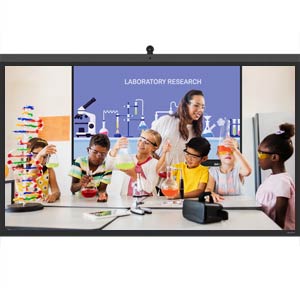 The importance of STEM (Science, Technology, Engineering, and Mathematics) education in today’s world cannot be overstated. As the backbone of technological advancement and innovation, STEM fields are crucial in driving economic growth, solving global challenges, and preparing students for future careers. However, teaching STEM subjects poses significant challenges, particularly in engaging students with abstract concepts and fostering a deep understanding of complex topics. To address these challenges, educators are increasingly turning to audio-visual (AV) technology, which has proven to be a powerful tool in making STEM education more accessible, interactive, and practical. Companies like Go Education lead the way by providing advanced AV solutions that transform the modern classroom into a dynamic environment where STEM learning thrives.
The importance of STEM (Science, Technology, Engineering, and Mathematics) education in today’s world cannot be overstated. As the backbone of technological advancement and innovation, STEM fields are crucial in driving economic growth, solving global challenges, and preparing students for future careers. However, teaching STEM subjects poses significant challenges, particularly in engaging students with abstract concepts and fostering a deep understanding of complex topics. To address these challenges, educators are increasingly turning to audio-visual (AV) technology, which has proven to be a powerful tool in making STEM education more accessible, interactive, and practical. Companies like Go Education lead the way by providing advanced AV solutions that transform the modern classroom into a dynamic environment where STEM learning thrives.
STEM education has traditionally been considered difficult to teach due to the abstract nature of many concepts within these disciplines. For instance, explaining the intricacies of chemical bonding, the vastness of the cosmos, or the complexities of calculus often leaves students disengaged and struggling to connect with the material. Traditional teaching methods, reliant on textbooks, lectures, and static diagrams, can take time to bring these subjects to life, leading to students’ lack of interest and understanding. This is particularly concerning when the demand for STEM professionals is rising, and the need to inspire the next generation of scientists, engineers, and technologists is more critical than ever.
This is where AV technology steps in, offering innovative ways to enhance the teaching and learning of STEM subjects. Educators can create immersive, interactive experiences that make complex concepts more tangible and relatable by integrating AV tools into the classroom. For example, digital projectors and interactive displays can transform a dull lecture on planetary motion into a vivid solar system simulation, allowing students to explore celestial bodies and their orbits in real-time. Similarly, 3D visualisation tools can help students understand molecular structures by enabling them to manipulate virtual models of atoms and compounds, turning abstract chemistry lessons into hands-on learning experiences.
One of the critical benefits of AV technology in STEM education is its ability to cater to different learning styles. Students who struggle with traditional text-based learning may find it easier to grasp concepts through visual and interactive media. For example, a student who finds it challenging to understand algebraic equations in a textbook may benefit from a digital whiteboard that allows them to visually manipulate variables and see the immediate effects of their changes. By accommodating diverse learning preferences, AV technology helps ensure that all students have the opportunity to succeed in STEM subjects, regardless of their preferred learning style.
Go Education offers a range of AV solutions specifically designed to support STEM education, helping schools and educators overcome the challenges of teaching these demanding subjects. One of their flagship products is the Promethean ActivPanel, an interactive display providing a versatile STEM instruction platform. The ActivPanel supports multi-touch functionality, allowing multiple students to engage with the content simultaneously, particularly useful for collaborative projects and group activities. The high-resolution display ensures that even the most detailed diagrams and simulations are rendered with clarity, making it easier for students to observe and analyse complex data.
Another innovative product Go Education offers is the SMART Board, which has become a staple in modern classrooms. The SMART Board’s intuitive interface allows teachers to actively deliver interactive lessons that involve students in the learning process. For STEM education, the SMART Board can demonstrate mathematical concepts through dynamic graphs, showcase engineering principles with interactive schematics, or conduct virtual science experiments where students can test hypotheses and observe outcomes in real-time. The SMART Board’s ability to integrate with a wide range of educational software further enhances its versatility, providing educators with endless possibilities for creating engaging STEM lessons.
AV technology in STEM education is not limited to enhancing understanding of individual concepts; it also plays a crucial role in developing critical thinking and problem-solving skills. Educators can create scenarios that challenge students to apply their knowledge in real-world contexts by incorporating AV tools into project-based learning. For example, students might be tasked with designing a sustainable energy system for a virtual city using engineering software displayed on an interactive whiteboard. This type of activity reinforces the technical content and encourages students to think creatively, work collaboratively, and develop solutions to complex problems—skills essential in STEM careers.
Implementing AV technology in the STEM classroom requires careful planning and a strategic approach to use it effectively. Educators must be familiar with the technology and understand how to integrate it into their curricula. Professional development and training are essential components of this process, as they equip teachers with the skills and confidence needed to maximise the potential of AV tools. Go Education supports schools in this endeavour by offering comprehensive training programmes and resources that help educators get the most out of their AV investments.
One practical strategy for integrating AV technology into STEM education is to start with small, manageable projects that allow both teachers and students to become comfortable with the tools. For example, a teacher might begin by using an interactive display to facilitate a single science lesson, gradually incorporating more complex applications as familiarity grows. Over time, AV technology can be expanded to include more ambitious projects, such as creating digital portfolios of student work or conducting virtual field trips that explore scientific concepts in real-world settings.
While the benefits of AV technology in STEM education are clear, there are challenges to its implementation that must be addressed. Budget constraints are often a significant barrier, as high-quality AV equipment can be costly. However, schools can explore funding options, such as grants, partnerships with technology companies, and community support, to make these investments more feasible. Additionally, ensuring all students have access to the necessary technology is crucial for equity in Education. Schools must consider strategies for providing devices and internet connectivity to students lacking these resources at home, ensuring that everyone can benefit from AV-enhanced learning.
Another challenge is the potential for technology to become a distraction rather than a tool for learning. To mitigate this risk, educators should establish clear guidelines for using AV technology in the classroom, ensuring it is used purposefully and aligned with educational goals. By setting expectations for how and when technology should be used, teachers can help students stay focused and engaged, using AV tools to enhance rather than detract from the learning experience.
In conclusion, AV technology offers a transformative opportunity for STEM education, providing the tools to make complex concepts more accessible, engaging, and understandable for students. By integrating AV solutions like interactive displays, digital projectors, and 3D visualisation tools into the classroom, educators can create a dynamic learning environment that caters to diverse learning styles and fosters critical thinking and problem-solving skills. Go Education‘s STEM-focused AV products, including the Promethean ActivPanel and SMART Board, provide educators with the resources to deliver high-quality, interactive STEM instruction.
As the demand for STEM professionals grows, schools must equip students with the skills and knowledge needed to succeed. By embracing AV technology, educators can inspire the next generation of scientists, engineers, and technologists, preparing them to tackle future challenges. While there are challenges to implementing AV technology in STEM education, with careful planning, strategic investment, and ongoing support, schools can overcome these obstacles and create a modern classroom where STEM learning thrives. In doing so, they will enhance educational outcomes and contribute to a brighter, more innovative future for all.
